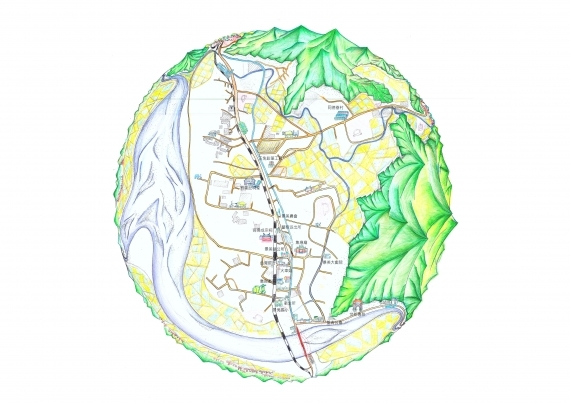Landscape of Jingmei during 1960–1980

Following its defeat on Mainland China, the Nationalist government retreated to Taiwan, developing industry nationwide. Jingmei Township, located close to Taipei City and accessible through Wan-Xin Railway, was an ideal location for running a factory. Many government organizations and military villages moved to Jingmei; this wave of migration started in the 1950s and peaked in the 1970s. Between 1960 and 1980, the agrarian Jingmei saw factories mushrooming and was developed into a residential region. This major change occurred after Jingmei, previously a town under Taipei County’s jurisdiction, was merged into Taipei City as a district in 1968.
During this period, Sections 5 and 6 of Roosevelt Road were dotted with factories on both sides. Many highly-regarded companies—e.g., Rabbit Industrial Corporation, Long Kow Foods, Max Factor, and Taiwan Veterans Pharmaceutical Co., Ltd—ran production bases in Jingmei. Public-sector firms, including the bottle manufacturing factory of Taiwan Tobacco and Wine Monopoly Bureau (the factory was formerly named “Taihoku Bottle Manufacturing Company”), a maintenance office of the Directorate General of Highways, the Military Law Bureau of the Ministry of National Defense, Public Works Bureau of Taiwan Provincial Government, and an asphalt plant, were also based in Jingmei. Some educational institutions that were outside the purview of compulsory education operated in Jingmei in the 1960s, such as Chingshin Academy, Taiwan Police College, and Chinese Municipal Vocational School (nowadays China University of Technology).
After Jingmei was merged into Taipei City as a district in 1968, it was designated as a residential region under the city’s urban plan. Consequently, no more new factories were established, and those previously based there relocated. Most of the land left by the relocated factories was designated for residential properties, and the rest for parks and markets. Some crop fields were converted into residential and commercial spaces, and others into parks and schools. In 1966, Guanghua New Village, a four-story condominium that stands behind Jingmei Junior High School, was built from crop fields. It is the first multi-dwelling unit ever built in Jingmei, and it has brought about major changes locally.
Between 1960 and 1980, many public-works projects were executed to improve Jingmei’s connection to the outside world. These projects are as follows:
-
Liugong Bridge was removed in 1963 because it was flood-prone.
-
In 1963, a levee was erected at the high riverbank in Xiaxizhou that spanned from Gongguan to Xizhikou, so as to make localities along the edge of the river less prone to floods. Above the levee was a road for vehicles.
-
Section 1 of Xinlong Road began operation in 1964 connecting with Section 5 of Roosevelt Road.
-
In 1965, Wan-Xin Railway was demolished, Sections 5 and 6 of Roosevelt Road were widened, and Beixin Bridge was built to connect with Beixin Road in Xindian.
-
The channel of the Liugongjun canal system in Jingwen Street was capped in 1968, becoming the eastern half side of the road.
-
In 1972, Xinhai Tunnel began operation; Section 4 of Xinhai Road was built to connect with Xinlong Road.
-
In 1974, Jingxing Road, connecting from Section 1 of Xinlong Road to Jingwen Street and Roosevelt Road, began service—and so did the section of Xinlong Road that spanned from Muzha Road to Muxin Road.
-
In 1977, heavy rains triggered a landslide down Toad Mountain. In the wake of this disaster, Sections 5 and 6 of Roosevelt Road were respectively widened to 36 m.
-
In 1978, Huaien Tunnel began operation, Sections 5 and 6 of Xinhai Road were built to connect with Muzha Road, and Zhonggang Road was renamed “Section 7 of Xinhai Road.

最新自 何文賢 / He Wen-hsien
- 1960年代的景美菜市場
- 己亥年(108年)景美聯合遶境
- 壬辰年(民國101年)景美集應廟迎香慶典
- 壬辰年(民國101年)景美聯合遶境慶典
- 文山興安宮
- 古亭地政事務所
- 未有大樓前的景美街景
- 由景文街看車前路
- 車前路地貌的改變
- 辛卯年(民國100年)北投集應廟至景美迎回保儀
- 原車前路上順泰玩具食品行
- 高選風遺墨
- 景文街林鶴年醫院舊宅
- 景美集應廟豬公祭典(一)
- 景美舊橋封橋待拆除
- 開道碑重置揭幕
- 瑠公圳舊道與新道會合點
- 興隆市場
- 1970年以前景美的工廠及公營機構
- 1980年以後景美的工廠及公營機構
- Liugong Bridge: the First Reinforced-Concrete Bridge in Taiwan
- Expected Changes for the Landscape of Jingmei After 2020
- Landscape of Jingmei during 2000–2020
- Landscape of Jingmei during 1980–2000
- Landscape of Jingmei before 1960
- The Stealthy Wansheng River
- Turning Jingmei River Channels into Parks
- A Potential Archeological Site of Shiwufen
- Xingfu Village Monument
- Earth God Temple in Jingmei
- History of Wan-Xin Railway
- Liugongjun and Wooden Trough Bridge
- History of Jingmei Bridge
- Coal Mining in Wenshan District
- Important Infrastructures in Wenshan District from the Past
- Changes in Jingmei’s Geography and Road Infrastructure
- History of Jingmei
- 霧裡薛圳圳路
- 景美街1號與2號距離遠
- 景美行政變遷
- 景美老街拱形騎樓元素
- 都更下的景美街困境
- 2000年至2020年景美地景變遷
- 1960年以前景美地景樣貌
- 1960年至1980年景美地景變遷
- 1980年至2000年景美地景變遷
- 2020年後景美地景變遷的期待
- 景美街商業土地使用分區
- 原貌仍在的泰興染織廠
- 中農化工廠基地變遷
- 1980年以後景美的工廠及公營機構
- 1970年以前景美的工廠及公營機構
- 興福庄「建塚記念碑」
- 金獎外觀興隆市場
- 臺北花木批發市場
- 疑似十五份遺址
- 會元洞清水祖師廟
- 景美福興宮
- 景美瑠公圳暨成巷道
- 景美忠勤三莊新面向
- 景美「賴氏萬壽塔」
- 頂公館福德宮
- 消失的興福庄浚溝修路石碑
- 和伯公紀念會館
- 台北江西會館及萬壽宮
- 在興隆路的台北畜產運銷公司
- 在景美的古亭地政事務所
- 文山興安宮
- 文山溪洲福德宮
- 三福街古道
- 十五分火車站
- 十五分庄舊地名
- 木柵集應廟保儀尊王巡境貓空
- 甲午年(103)木柵集應廟巡境慶典
- 景美集應廟豬公祭典
- 仙跡岩拾遺
- 仙跡岩的民間信仰
- 仙跡岩舊八景
- 龍吃水的地理景觀
- 圳後山的圖根點
- 景美山的三角點
- 百年金龜樹生病了
- 景美其他的老樹
- 景行公園的老樹
- 景美養工處老樹
- 巷內的魯花樹
- 興安宮的老榕樹
- 景豐街的老樹
- 萬有公園的老樹
- 萬和公園的老樹
- 景美國中的老樹
- 景美國小附近老樹
- 景美國小的老樹
- 萬新鐵路的歷史
- 景美聖方濟沙勿略堂
- 景美的西方教會彙總
- 味自慢居酒屋
- 義興樓食堂
- 景美的春燕
- 萬盛溪舊溪床旁的春燕


